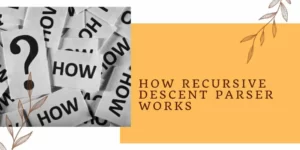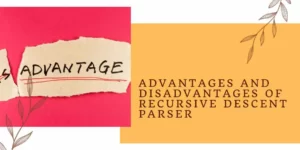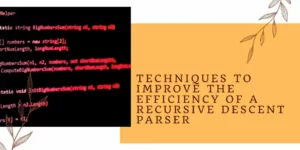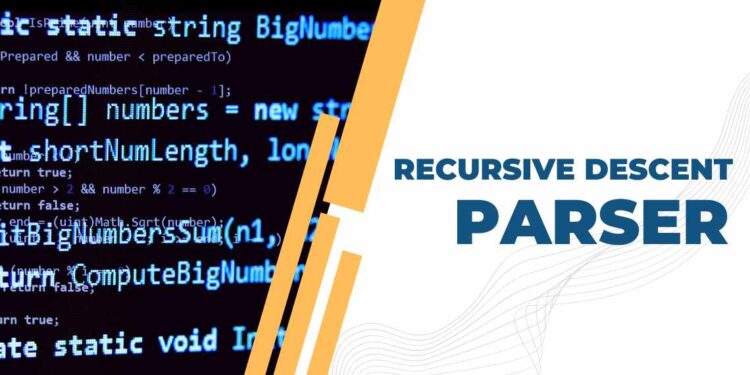Table of Contents
ToggleIntroduction
A Recursive Descent Parser (RDP) is a type of top-down parsing technique used in computer science to analyze and process a language’s syntax. The RDP method involves starting at the highest level of the syntax and recursively descending through each production rule until reaching the final token in the language. During this process, the parser analyzes the input text and generates a parse tree, which represents the structure of the input text according to the language’s grammar rules.
One of the advantages of using RDP is that it’s relatively easy to implement, as it involves writing a set of parsing functions that correspond to the language’s grammar rules. Additionally, the RDP method can handle a wide variety of context-free grammar, making it a popular choice in programming language design.
However, RDP has some limitations, such as being unable to handle left-recursive grammars, which can cause infinite loops in the parsing process. Additionally, RDP can suffer from efficiency issues when processing large grammar or complex input text.
Overall, RDP is a useful tool in the world of programming language design and syntax analysis. With a good understanding of the RDP method and its advantages and limitations, programmers can implement efficient and effective parsing algorithms to analyze and process a wide variety of programming languages and other textual data.
How Recursive Descent Parser Works

A Recursive Descent Parser (RDP) works by recursively descending through the grammar rules of a language to analyze and process the syntax of the input text. This process begins at the top level of the grammar, where the parser identifies the non-terminal symbol that corresponds to the starting rule of the language. The parser then calls the corresponding parsing function for that non-terminal symbol, which recursively calls parsing functions for each of its sub-rules.
During this process, the parser compares the current input token to the expected token for the current rule, using lookahead to determine which rule to follow next. If the current input token matches the expected token, the parser moves on to the next token and continues the parsing process. If the input token does not match the expected token, the parser generates a syntax error and stops processing the input text.
As the parser descends through the grammar rules, it builds a parse tree that represents the structure of the input text according to the language’s grammar rules. This parse tree can then be used to further analyze and process the input text, such as by generating code or performing semantic analysis.
Overall, the RDP method provides a simple and efficient way to analyze and process the syntax of a language. By recursively descending through the grammar rules, the parser can efficiently handle a wide variety of context-free grammar, making it a popular choice for parsing algorithms in programming language design.
Advantages and Disadvantages of Recursive Descent Parser

A recursive Descent Parser (RDP) has several advantages and disadvantages, which are outlined below.
Advantages:
Ease of implementation: RDP is relatively easy to implement since it involves writing a set of parsing functions that correspond to the grammar rules of the language.
Human-readable error messages: When an error occurs during parsing, RDP can provide detailed and human-readable error messages that can help programmers quickly identify and fix syntax errors.
Flexibility: RDP can handle a wide variety of context-free grammar, making it a popular choice for parsing algorithms in programming language design.
Incremental parsing: RDP can parse the input text incrementally, which means it can start generating a parse tree before the entire input text has been processed.
Disadvantages:
Limited handling of left-recursive grammars: RDP cannot handle left-recursive grammars, which can cause infinite loops in the parsing process.
Inefficiency: In some cases, RDP can suffer from efficiency issues when processing large grammar or complex input text, especially when compared to other parsing techniques such as LR parsing.
Limitations in error recovery: Since RDP generates syntax errors immediately upon encountering an unexpected token, it can be less effective than other parsing techniques at recovering from errors and continuing parsing.
Difficulty handling ambiguous grammars: RDP may struggle to handle grammars that are inherently ambiguous or have multiple valid parse trees.
Overall, RDP is a useful and flexible parsing technique that is well-suited for many programming languages and other textual data. However, it’s important to be aware of its limitations, particularly when working with large or complex grammar.
Click here to know more about data science course fees in Mumbai
Steps to Implement a Recursive Descent Parser

The following are the general steps to implement a Recursive Descent Parser (RDP):
Define the grammar: Define the context-free grammar for the language you want to parse. The grammar should be written in BNF (Backus-Naur Form) or a similar notation.
Convert the grammar into parsing functions: Write parsing functions that correspond to each non-terminal symbol in the grammar. Each parsing function should follow the same basic structure, starting with an expected token check and then recursively calling other parsing functions for sub-rules.
Define the lexer: Write a lexer that reads the input text and converts it into a stream of tokens. Each token should have a type and a value that can be used by the parsing functions.
Call the start symbol parsing function: Call the parsing function for the start symbol of the grammar, passing in the token stream generated by the lexer.
Build the parse tree: As the parsing functions execute, build a parse tree that represents the structure of the input text according to the grammar rules.
Handle syntax errors: If the parsing functions encounter a syntax error, generate an error message and halt parsing. Depending on the requirements of your application, you may need to implement error recovery techniques to resume parsing after an error.
Use the parse tree: Once the parsing process is complete, you can use the parse tree to perform further analysis or generate code for the input text.
These steps are a general guideline for implementing an RDP. However, the specific implementation details will vary depending on the programming language and parsing tools you are using. It’s important to have a good understanding of the language’s grammar and syntax before attempting to write an RDP for it and to test the parsing functions thoroughly to ensure correct and efficient parsing.
Common Errors and Challenges Faced While Implementing a Recursive Descent Parser
Implementing a Recursive Descent Parser (RDP) can come with several challenges and errors, some of which are outl
ined below:
Left-recursive grammar: RDP cannot handle left-recursive grammars, which can cause infinite loops in the parsing process. This can be solved by using a different parsing technique, such as LR parsing.
Ambiguous grammar: RDP may struggle to handle grammars that are inherently ambiguous or have multiple valid parse trees. This can lead to incorrect or unpredictable behavior and may require additional analysis or reworking of the grammar rules.
Recursive descent stack overflow: Depending on the complexity of the grammar and input text, RDP may encounter issues with stack overflow due to excessive recursion. This can be mitigated by optimizing the parsing functions or using a parser generator tool.
Unexpected input tokens: RDP generates syntax errors immediately upon encountering an unexpected token, Recursive Descent Parser, which can make it less effective than other parsing techniques at recovering from errors and continuing parsing. This can be addressed by implementing error recovery techniques, such as panic mode recovery or error correction.
Efficiency issues: In some cases, RDP can suffer from efficiency issues when processing large grammar or complex input text, especially when compared to other parsing techniques such as LR parsing. This can be mitigated by optimizing the parsing functions or using a parser generator tool.
Overall, it’s important to be aware of the potential errors and challenges when implementing an RDP and to thoroughly test the parsing functions to ensure correct and efficient parsing. It may also be helpful to use parser generator tools or other automated solutions to streamline the implementation process and reduce the potential for errors.
Techniques to Improve the Efficiency of a Recursive Descent Parser

Recursive Descent Parser (RDP) can face efficiency issues when processing large grammar or complex input text. Below are some techniques that can be used to improve the efficiency of an RDP:
Memoization: Memoization is a technique used to cache the results of parsing functions, so they don’t have to be recomputed every time the same input is encountered. This can significantly reduce the number of function calls and improve parsing performance.
Parsing table: A parsing table is a data structure that maps non-terminal symbols and input tokens to parsing functions. Using a parsing table can reduce the number of function calls and make the parsing process more efficient.
Tail recursion elimination: Eliminating tail recursion in parsing functions can reduce the amount of memory required for the parsing stack, which can improve parsing performance.
Lookahead optimization: In some cases, parsing functions can be optimized by looking ahead at the next few tokens in the input stream and making decisions based on that information. This can reduce the number of function calls and improve parsing performance.
Precedence parsing: Precedence parsing is a technique used to handle operator precedence in the input text. Recursive Descent Parser, By assigning priorities to different operators, the parsing process can be optimized to reduce the number of function calls and improve parsing performance.
Parser generator tools: Using parser generator tools can automate the process of generating parsing functions from a grammar specification, which can result in more efficient parsing code and reduce the potential for human error.
Overall, improving the efficiency of an RDP requires a deep understanding of the grammar and parsing process and may require experimentation and testing to identify the most effective optimization techniques for a particular use case.
Comparison of Recursive Descent Parser with Other Parsing Techniques
Recursive Descent Parser (RDP) is a top-down parsing technique that has advantages and disadvantages compared to other parsing techniques, including:
LL and LR parsing: LL parsing is another top-down parsing technique that is similar to RDP but uses a parsing table to reduce the number of function calls. LR parsing, on the other hand, is a bottom-up parsing technique that uses a stack to build parse trees from the input text. Both LL and LR parsing is generally more efficient than RDP and can handle a wider range of grammar.
Packrat parsing: Packrat parsing is a variation of RDP that uses memoization to improve parsing efficiency. Recursive Descent Parser, This technique can handle left-recursive grammars and other complex grammars that are difficult for traditional RDP, but it requires more memory and may not be as efficient as LL or LR parsing.
Earley parsing: Earley parsing is a dynamic programming-based parsing technique that can handle a wide range of grammar, including ambiguous grammar. It can be more efficient than RDP for some types of grammar, but it requires more memory and may be slower for certain input text.
Recursive ascent parsing: Recursive ascent parsing is a variation of RDP that can handle left-recursive grammars and other complex grammars by using a parsing stack. It is generally more efficient than packrat parsing, but may not be as efficient as LL or LR parsing.
In summary, RDP is a simple and intuitive parsing technique that is easy to implement and understand, but it has limitations in terms of efficiency and the types of grammar it can handle. Other parsing techniques, such as LL and LR parsing, can handle more complex grammar and may be more efficient in some cases, but they may be more difficult to implement and understand. The choice of parsing technique ultimately depends on the specific requirements of the application and the characteristics of the input text and grammar.
Recursive Descent Parser in context with top-down parsing
A recursive Descent Parser (RDP) is a type of top-down parsing technique that starts from the root of the parse tree and recursively applies production rules to generate the input text. In top-down parsing, the parser starts from the top level of the grammar and works its way down to the input text.
Top-down parsing techniques, including RDP, are generally easy to implement and understand, and they can be used to generate parse trees in a straightforward manner. However, they have limitations in terms of the types of grammar they can handle. For example, left-recursive grammars can cause infinite recursion in RDP, and some grammars may require backtracking or look-ahead to resolve ambiguities.
To overcome these limitations, other top-down parsing techniques have been developed, such as LL and LR parsing. These techniques use parsing tables and automata to reduce the number of function calls and handle more complex grammar. LL parsing, in particular, is a table-driven top-down parsing technique that can handle a wide range of context-free grammar and is more efficient than RDP in many cases.
In summary, RDP is a type of top-down parsing technique that can be used to generate parse trees by recursively applying production rules. While RDP is simple and intuitive, it has limitations in terms of the types of grammar it can handle. Other top-down parsing techniques, such as LL and LR parsing, have been developed to handle more complex grammar and improve parsing efficiency.
Also read: data science course in Indore
Applications of Recursive Descent Parser in Programming Languages
Recursive Descent Parser (RDP) has many applications
in programming languages. Here are a few examples:
Compiler construction: RDP is a widely used technique in compiler construction to parse the source code of programming languages. RDP can be used to generate the syntax tree of a program, which can then be translated into machine code or bytecode.
Syntax highlighting: RDP can also be used to perform syntax highlighting in code editors and IDEs. Syntax highlighting highlights different parts of the code, such as keywords, variables, and comments, to make the code more readable and easier to understand.
Code analysis: RDP can be used to perform code analysis to check for errors and improve the quality of the code. RDP can be used to check the syntax of the code and ensure that it conforms to the rules of the programming language.
Code generation: RDP can also be used to generate code automatically, such as generating boilerplate code for a project or generating code from a graphical user interface.
Program verification: RDP can be used to verify that a program satisfies certain properties, such as being deadlock-free or being free of race conditions. RDP can be used to check the syntax of the program and analyze its control flow to verify that it meets certain requirements.
In summary, RDP has many applications in programming languages, including compiler construction, syntax highlighting, code analysis, code generation, and program verification. RDP can be used to generate parse trees, check for errors, and improve the quality of the code.
Conclusion
In conclusion, Recursive Descent Parser (RDP) is a widely used parsing technique that is simple and easy to implement. RDP has many applications in programming languages, including compiler construction, syntax highlighting, code analysis, code generation, and program verification.
However, RDP also has some limitations, such as difficulty in handling left-recursive grammar and performance issues with backtracking. Therefore, other parsing techniques such as LL and LR parsing have been developed to overcome these limitations.
Despite the limitations of RDP, it still has a bright future in the world of programming. recursive descent parser algorithm, simplicity, and ease of implementation make it a popular choice for small-scale projects and educational purposes. Furthermore, recent developments in optimizing RDP and incorporating it with other parsing techniques have improved its performance and made it more suitable for large-scale projects.
Moreover, with the increasing demand for efficient and effective programming languages, RDP is likely to continue to play a crucial role in the development of programming languages and compilers. As technology continues to evolve, RDP will continue to be an important tool for programmers, and it will likely remain a popular choice for small-scale projects and educational purposes.
Overall, while RDP may not be the most sophisticated parsing technique, it is an important part of the programming landscape, and its future remains bright.
Frequently Asked Questions
What is a Recursive Descent Parser?
A Recursive Descent Parser is a top-down parsing technique that is used to analyze and interpret programming languages by breaking down the input into a set of grammar rules.
What are the advantages of Recursive Descent Parser?
Recursive Descent Parser has a few advantages, including its simplicity, ease of implementation, and the ability to easily generate parse trees for the input.
What are the limitations of Recursive Descent Parser?
Recursive Descent Parser has limitations in handling left-recursive grammars and handling ambiguous grammars. It also requires a separate function for each non-terminal symbol in the grammar.
How is Recursive Descent Parser different from other parsing techniques?
Recursive Descent Parser is a top-down parsing technique, meaning it starts at the highest level of the grammar and works its way down to the input. Other parsing techniques like LL and LR parsing are bottom-up parsing techniques that start with the input and work their way up to the top level of the grammar.
What are the applications of Recursive Descent Parser?
Recursive Descent Parser has applications in many programming language tasks, including compiler construction, syntax highlighting, code analysis, code generation, and program verification. It can also be used for generating parse trees, checking for syntax errors, and improving the quality of the code.













